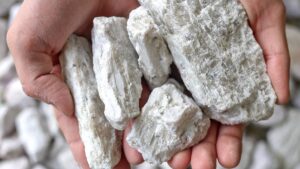Eye on Lithium: China chats with Taliban about accessing Afghan lithium, Core flies on Tesla tieup

Pic: Getty
- Core nabs offtake deal with Tesla for NT project
- Metals Australia picks up high grade lithium in rock chips, drill program ongoing
- PAM releases assays, eyes lower carbon emission lepidolite
All your ASX lithium news for Wednesday, March 2.
The Special Inspector General for Afghanistan Reconstruction (SIGAR) has tweeted that Chinese companies are looking access Afghanistan’s lithium and copper deposits.
China has had their eye on the country’s vast mineral resource since the Taliban took over last year, and SIGAR said that industry representatives have now met with Taliban officials to discuss mining rights and research access.
(2/2)…Chinese mining companies have been scouting opportunities to access #Afghanistan’s lithium & copper deposits. Chinese mining industry representatives met with Taliban officials to discuss mining rights and research access to such mineralshttps://t.co/LuV5DzXzky
— SIGAR (@SIGARHQ) February 27, 2022
The Taliban is desperate to collect domestic revenue, introducing new royalties for the export of raw materials which are four times higher than that of the Ghani administration.
Afghanistan has lithium deposits which are estimated to be worth around $1 trillion and which SIGAR said could rival Bolivia’s 21MT.
SIGAR also said that most projects require a 5-10 year lead time, significant improvements in security and a more investor friendly regulatory environment.
And while China is trying to get the ball rolling, it looks like the Taliban is throwing their support behind Ukraine, supplying the country with weapons and lithium.
BREAKING NEWS: Ukraine has signed a trade deal with Afghanistan. We will be supplying carpets, military weapons, wool, cotton and lithium. pic.twitter.com/AzYm0R04La
— Islamic Emirate of Afghanistan Public Relations (@PublicAfghan) February 28, 2022
Here’s how ASX lithium stocks are tracking today:
| Code | Company | Price | % Month | % Week | % Today | Market Cap |
|---|---|---|---|---|---|---|
| MLS | Metals Australia | 0.0925 | 131% | 120% | 75% | $13,882,189.04 |
| TSC | Twenty Seven Co. Ltd | 0.005 | 25% | 25% | 25% | $10,643,255.62 |
| AZL | Arizona Lithium Ltd | 0.145 | -9% | 26% | 16% | $249,720,806.88 |
| CXO | Core Lithium | 0.945 | 20% | 25% | 15% | $1,397,821,630.43 |
| BNR | Bulletin Res Ltd | 0.175 | 52% | 40% | 13% | $44,261,786.05 |
| LPD | Lepidico Ltd | 0.034 | -11% | 21% | 10% | $193,409,940.63 |
| SCN | Scorpion Minerals | 0.073 | -3% | 7% | 7% | $18,326,421.06 |
| AX8 | Accelerate Resources | 0.045 | 18% | 5% | 7% | $10,645,273.76 |
| ENT | Enterprise Metals | 0.015 | 1% | 0% | 7% | $8,022,282.03 |
| PAM | Pan Asia Metals | 0.545 | -11% | 9% | 7% | $37,565,908.44 |
| CAI | Calidus Resources | 0.815 | 9% | 18% | 7% | $306,202,735.71 |
| KGD | Kula Gold Limited | 0.049 | 9% | 20% | 7% | $9,898,079.07 |
| BYH | Bryah Resources Ltd | 0.05 | -12% | 2% | 6% | $10,631,737.23 |
| RMX | Red Mount Min Ltd | 0.0085 | -15% | -6% | 6% | $13,138,910.86 |
| JRL | Jindalee Resources | 2.9 | 14% | 6% | 6% | $148,244,866.84 |
| RLC | Reedy Lagoon Corp. | 0.0275 | -24% | 6% | 6% | $14,244,287.98 |
| WML | Woomera Mining Ltd | 0.019 | -14% | 19% | 6% | $12,272,995.19 |
| KAI | Kairos Minerals Ltd | 0.022 | -15% | -4% | 5% | $41,203,963.31 |
| NVA | Nova Minerals Ltd | 0.61 | -30% | -30% | 4% | $105,418,336.73 |
| ESS | Essential Metals Ltd | 0.37 | -26% | 14% | 4% | $86,707,675.06 |
| ESS | Essential Metals Ltd | 0.37 | -26% | 14% | 4% | $86,707,675.06 |
| PSC | Prospect Res Ltd | 0.875 | 4% | 4% | 4% | $362,844,892.80 |
| TON | Triton Min Ltd | 0.03 | -12% | 7% | 3% | $36,040,741.13 |
| FG1 | Flynngold | 0.15 | -13% | -9% | 3% | $9,288,852.25 |
| LPI | Lithium Pwr Int Ltd | 0.61 | -20% | 13% | 3% | $205,774,210.32 |
| AVZ | AVZ Minerals Ltd | 0.8775 | 18% | 22% | 3% | $2,934,253,618.00 |
| CHR | Charger Metals | 0.65 | -17% | 3% | 3% | $20,515,551.84 |
| FRS | Forrestaniaresources | 0.35 | -7% | 25% | 3% | $9,553,593.36 |
| ARN | Aldoro Resources | 0.38 | 0% | -4% | 3% | $33,166,277.93 |
| FFX | Firefinch Ltd | 0.705 | 8% | 16% | 2% | $812,913,978.00 |
| A8G | Australasian Metals | 0.47 | -16% | -1% | 2% | $18,478,427.24 |
| AML | Aeon Metals Ltd. | 0.05 | 9% | 6% | 2% | $42,424,635.51 |
| PGD | Peregrine Gold | 0.5 | -5% | -12% | 2% | $18,677,882.72 |
| SYA | Sayona Mining Ltd | 0.1275 | -2% | 16% | 2% | $887,115,152.38 |
| INF | Infinity Lithium | 0.1375 | -14% | -5% | 2% | $56,001,974.54 |
| BMM | Balkanminingandmin | 0.285 | -29% | -12% | 2% | $9,170,000.00 |
| AS2 | Askarimetalslimited | 0.355 | 3% | 3% | 1% | $13,345,508.75 |
| GL1 | Globallith | 1.49 | -7% | 9% | 1% | $200,097,243.78 |
| LEL | Lithenergy | 0.925 | -13% | 8% | 1% | $41,175,000.00 |
| LKE | Lake Resources | 0.97 | 6% | 7% | 1% | $1,173,601,437.12 |
| IGO | IGO Limited | 11.77 | 0% | 7% | 1% | $8,829,742,699.58 |
| NMT | Neometals Ltd | 1.48 | 2% | 20% | 1% | $806,113,302.12 |
| VUL | Vulcan Energy | 9.29 | -1% | 12% | 1% | $1,215,084,180.70 |
| AKE | Allkem Limited | 9.76 | 6% | 11% | 1% | $6,183,998,184.20 |
| GT1 | Greentechnology | 0.815 | -11% | 16% | 1% | $85,860,000.00 |
| MIN | Mineral Resources. | 45.54 | -21% | 0% | 0% | $8,558,691,562.52 |
| PLS | Pilbara Min Ltd | 2.805 | -14% | 1% | 0% | $8,335,030,247.60 |
| ADV | Ardiden Ltd | 0.0125 | -17% | 4% | 0% | $33,258,029.45 |
| GXY | Galaxy Resources | 0 | -100% | -100% | 0% | $2,715,139,305.12 |
| LIT | Lithium Australia NL | 0.11 | -4% | -4% | 0% | $113,582,765.56 |
| PLL | Piedmont Lithium Inc | 0.72 | 7% | 13% | 0% | $381,228,408.00 |
| TKL | Traka Resources | 0.011 | -27% | 10% | 0% | $7,576,520.17 |
| AAJ | Aruma Resources Ltd | 0.085 | 0% | -1% | 0% | $13,341,727.76 |
| AM7 | Arcadia Minerals | 0.225 | -4% | 2% | 0% | $7,873,312.50 |
| DTM | Dart Mining NL | 0.098 | 27% | 3% | 0% | $12,200,111.14 |
| EMS | Eastern Metals | 0.195 | -15% | -7% | 0% | $6,942,000.00 |
| GSM | Golden State Mining | 0.084 | -12% | -1% | 0% | $6,979,390.74 |
| IMI | Infinitymining | 0.17 | 3% | -3% | 0% | $9,775,000.00 |
| MMC | Mitremining | 0.18 | -3% | 0% | 0% | $4,875,318.00 |
| SHH | Shree Minerals Ltd | 0.02 | 82% | 18% | 0% | $21,264,737.84 |
| TMB | Tambourahmetals | 0.22 | -14% | -6% | 0% | $9,062,371.56 |
| TEM | Tempest Minerals | 0.023 | -4% | 0% | 0% | $9,151,720.65 |
| WCN | White Cliff Min Ltd | 0.026 | 4% | 8% | 0% | $16,916,286.37 |
| KZR | Kalamazoo Resources | 0.295 | -12% | -2% | 0% | $42,832,340.33 |
| STM | Sunstone Metals Ltd | 0.079 | -1% | 0% | 0% | $176,922,157.34 |
| AVW | Avira Resources Ltd | 0.005 | 0% | -17% | 0% | $10,593,950.00 |
| EFE | Eastern Resources | 0.052 | -12% | 6% | 0% | $51,240,425.86 |
| MQR | Marquee Resource Ltd | 0.105 | -19% | 0% | 0% | $22,722,273.21 |
| SRZ | Stellar Resources | 0.027 | 17% | 8% | 0% | $22,607,170.90 |
| GLN | Galan Lithium Ltd | 1.415 | -11% | 6% | -1% | $423,024,572.33 |
| INR | Ioneer Ltd | 0.55 | -20% | 3% | -1% | $1,138,054,361.45 |
| LTR | Liontown Resources | 1.505 | 3% | 14% | -1% | $3,332,182,300.96 |
| EUR | European Lithium Ltd | 0.096 | -17% | 13% | -1% | $111,732,786.70 |
| PNN | PepinNini Minerals | 0.415 | -17% | 1% | -1% | $25,711,691.88 |
| WR1 | Winsome Resources | 0.35 | -23% | -1% | -1% | $47,733,297.87 |
| AGY | Argosy Minerals Ltd | 0.32 | -7% | 8% | -2% | $426,714,142.08 |
| AZI | Altamin Limited | 0.062 | -9% | -15% | -2% | $24,498,932.98 |
| QPM | Queensland Pacific | 0.1425 | -16% | 10% | -2% | $223,751,404.00 |
| MRR | Minrex Resources Ltd | 0.056 | -13% | -2% | -2% | $50,306,356.62 |
| ASN | Anson Resources Ltd | 0.1175 | -16% | 12% | -2% | $122,567,913.60 |
| EMH | European Metals Hldg | 1.175 | -19% | 1% | -2% | $168,452,358.00 |
| QXR | Qx Resources Limited | 0.045 | 18% | 32% | -2% | $34,769,666.77 |
| CRR | Critical Resources | 0.077 | -30% | 1% | -3% | $116,713,533.66 |
| LRV | Larvottoresources | 0.19 | 6% | -10% | -3% | $7,874,587.50 |
| LRS | Latin Resources Ltd | 0.036 | 20% | 0% | -3% | $53,380,534.77 |
| MTM | Mtmongerresources | 0.155 | 7% | -3% | -3% | $4,993,605.28 |
| RDT | Red Dirt Metals Ltd | 0.53 | -22% | -5% | -4% | $140,335,560.75 |
| RAG | Ragnar Metals Ltd | 0.026 | -37% | -19% | -4% | $10,062,492.00 |
| 1MC | Morella Corporation | 0.019 | -37% | 0% | -5% | $103,524,279.72 |
Who’s got news out today?
The NT developer has locked in a binding four-year offtake deal that will ship 110,000t of spodumene concentrate to Tesla from 2023.
Core’s 175,000tpa Finniss mine is due to open in late 2022, but it is already looking at options to expand to capture the astonishing demand uptick in lithium and EV markets after signing the supply deal with the world’s preeminent electric vehicle producer.
Core has already locked in separate 75,000tpa supply agreements for its first four years of production with China’s Yahua and Ganfeng, with the Tesla deal securing its initial offtake commitments.
“The whole of the world’s electric vehicle goals are going to be limited by the amount of lithium and raw materials needed to actually achieve those goals,” MD Stephen Biggins said.
“So new supply like Core is bringing to market later this year is rare, and well sought after by some of the biggest names in the car manufacturing industry.”
Core also says Tesla will assist it with Stage 3 plans for a potential chemical processing facility near the $89 million mine, which will generate $1.3 billion in revenue over its first 10 years on current planned production rates.
The Tesla supply deal is expected to begin in the second half of 2023, linked to prevailing spot prices with floor and ceiling prices.
This battery metals minnow has found some rock chip samples grading up 2.3% lithium and 0.7% rubidium at the ‘Mandini’ project in WA.
Hard rock lithium mines usually grade between 1-1.5% lithium, but high-grade rock chips aren’t much to get excited about on their own, as they could’ve been transported to this location from elsewhere by an ancient river or earthquake, for example.
The only way to prove if there is economic mineralisation is by drilling, which is well underway, MLS says.
The 45 hole, ~3,500m drilling program is currently testing the central, high-grade, part of the ‘Foundation’ pegmatite.
Initial testing has already intersected up to 16m downhole of mineralised pegmatite in RC drillhole MNRC043.
The identification of significant rubidium at Mandini is also highly encouraging, MLS says.
“Rubidium is a rare metal mostly employed in high-technology industries such as biomedical research, electronics, specialty glass and pyrotechnics as well as traditional uses in electronic devices, specialised glass and catalysts,” it says.
“Rubidium carbonate (Rb2CO3) pricing is currently reported by International Lithium Corp. to be up to US$1,060/kg, a factor of more than 75 times the current price of lithium carbonate (Li2CO3) at US$14/kg (US$13,970/t).”
The lithium explorer has released new assays from 7 drill holes at its Reung Kiet Lithium project in Thailand, and MD Paul Lock said the lithium, tin and tantalum, and cesium, rubidium and potassium results are in line or better than PAM’s direct peers.
“We are also seeing many intersections better than 0.10% tin and these intersections are commonly associated with tantalum values higher than 100ppm,” he said.
“Both tin and tantalum have the potential to be valuable by-product credits during beneficiation, especially in the current price environment.”
The company is rapidly progressing to an inaugural mineral resource, which will be used as part of a Scoping Study that plans to consider initial production of up to 10,000tpa of LCE and associated by-products.
PAM is focusing on lepidolite as a source of lithium as peer group studies indicate that lithium carbonate and lithium hydroxide projects using lepidolite as their plant feedstock have the potential to be placed at the bottom of the cost curve.
Lepidolite has also been demonstrated to have a lower carbon emission intensity than other lithium sources.
Related Topics

UNLOCK INSIGHTS
Discover the untold stories of emerging ASX stocks.
Daily news and expert analysis, it's free to subscribe.
By proceeding, you confirm you understand that we handle personal information in accordance with our Privacy Policy.








